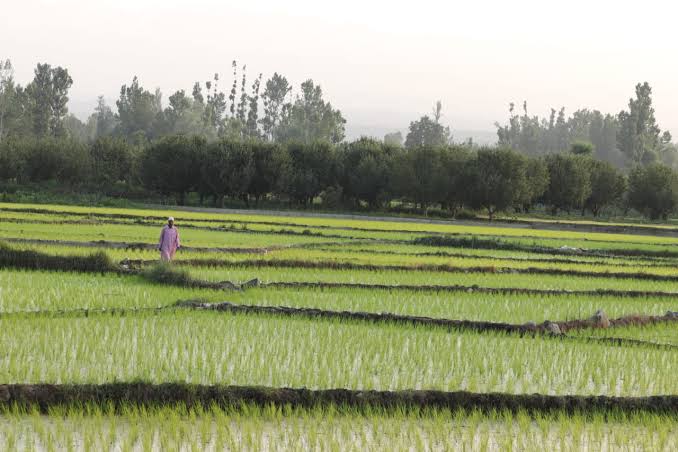
Latief U Zaman Deva
SRINAGAR , MARCH ,21 :
Under Naya Kashmir , a socio- economic treatise formulated before partition, J&K was envisioned to be a Country which was a common perception in all Indian States about their respective Govtts under British suzereinty.The promised land reforms aimed at abolishing absentee landlordism foisted on the peasantry from 1846 by the despotic rulers. The transfer of Land in ownership rights to the tenants for its better utilisation by them was concluded as the only alternative for attaining critical landmarks in the production of food grains & other cereals leading eventually the State towards self Sufficiency in this behalf. These underlying thematic twin aspects of epoch making Land reforms could not have been achieved unless restrictions were laid down on utilisation of the Land and its alienation also regulated.
Legal framework
2) Before the de-operationalisation of Article 370 & enactment of The J&K Re-organisation Act 2019 the laws listed below dealt with the subject of use of agricultural Land & conversion in its use :-
The J&K Agrarian Reforms Act 1976,
The J&K Land Revenue Act Svt 1996,
The J&K Big Landed Estates Act Svt 2007,
The J&K Land Utilisation Act Svt 2010 &
The J&K Prohibition on Conversion of Land & Alienation of Orchards Act 1975.
3) The Laws figuring at srl Nos 3 to 5 stand repealed as a whole & wherever warranted in the estimation of Govtt of India (MHAs) & UT Govtt selective coverage provided to relevant provisions of the repealed laws by amending & substituting various provisions of remaining two laws in force. Before amendments carried out vide SO 3808 Dated 26.10.2020 Section 13 of the Agrarian Reforms Ac provided that after 13.07.1978 ( commencement of the Act) a person can hold Land for personal cultivation only except wherever tenancy permitted, for residential purposes upto 2 kanals per family or subject to the provisions of repealed law ( srl no v) Ibid for horticulture purposes or with permission of Revenue Minister/ his delegatee for industrial and commercial purposes. After ist May 1973 tenancy created in respect of any Land is invalid except in cases where permitted ( Religious Institutions and places) & It is this later part of the section only ( forbidding the creation of tenancy) which continues on the statute and rest of the provisions have been omitted. The restrictions omitted have, however, been introduced in a holistic manner by substituting/ inserting Sections 133-A, 133-B, 133-C & 133-D in Land Revenue Act. The salient features emerging from forementioned provisions of law are as under:-
No Land used for agricultural purposes can be used for non- agricultural purposes except where permitted by the Distt Collector (DC) . The permission in case of saffron Land to be processed in accordance with the J&K Saffron Act 2007. The Board of Revenue in J&K charged with the responsibility for notifying procedures etcs enabling DCs to grant permissions,
The owner of agricultural land has been enabled to raise construction thereon for residential purposes or agricultural improvement subject to the ceiling of 400 Sq mtrs ( 4305 Sq feet) in total,
Any attempt to convert agricultural Land into non-agricultural use by contravening the provisions of Sec 133-A is deemed as violation of the Land Revenue Act. However the non agricultural use in conformity with Regional Plan, Development Plan Or Master Plan doesn’t attract evil consequences provided the prescribed conversion charges are paid. The redeeming feature is that the areas notified by the Govtt as Eco-sensitive Zones (ESZs) are exempted from the jurisdiction of Distt Collectors and others & hence no permission can be granted for conversion in Land use insofar ESZs are concerned ,
The Distt collectors have been empowered to grant permissions subject to prescribed limits for change in the use of proprietary Land falling under the categories of grazing, arak, kap, kahi krishm Or which grows fuel & fodder & belongs to such class as is notified by the Govtt &
V)The land converted for purposes other than agricultural or grazing etcs in violation of Sec 133-A, 133-B & 133-BB vests in the State subject to grant of opportunity to the person ,found to have violated the law, to remove the contraventions.
Alienation / transfer of Land and protection to “Agriculturalists”.
4) Sections 13 & 28-A of the Agrarian Reforms Act laid down a highly restrictive mechanism for alienations by vesting the powers at highest level in the Revenue Minister & placed total embargo on transfer of Land, the ownership rights whereof acquired under the Act of 1976 ,in favour of any person except the Govtt of J&K respectively. Under existing provisions the aforementioned embargo has been removed by relaxing the prohibition enabling beneficiaries of Land reforms to transfer such Land after expiry of 15 years from the date the said Land has vested in the State u/S 4 but subject to the provisions of Sections 133-H to 133-L of the Land Revenue Act. In addition, grant of lease, contract farming and transfer in the form of simple mortgage have been added. In the event of a transfer of land Or rights therein not falling under above, such course of action is deemed as null & void resulting in its vesting in the State after providing an opportunity of being heard. U/Sec 133-H no Land or rights therein can be transferred to a non- agriculturalist & “Agriculturist” is one who has been cultivating Land personally in J&K on Ist November 2021 as notified vide S. O.373 Dated 01.11.2021 or such category of persons as may be notified from time to time. However the Govtt is empowered to allow an agriculturalist to alienate Land to a non agriculturist through the medium of Sale, gift, exchange or mortgage.
5) The Liberalised legal framework, being implemented for National/ UT Industrial policies including Hospitality, Services & Housing sectors may diminish faster cultivable land unless a) the alienation is restricted in favour of Land owners owning Land adjacent to the alienor’s holdings on rates determined by the Collector who shall adopt the rates prescribed for stamp purposes as minimum for assessing & fixing the prevailing current market rates to prevent distress sales or cartlelisation in the procedures. This shall also put to an end the fragmentation of the land holdings & non – agricultural use of unviable land units, b) Land obtained under Land reforms not to be used for purposes other than agricultural & allied purposes like fruit bearing trees, vegetables and other cash crops, & c) the sites used and recorded as Village Abadies to continue to be as such & complemented by introduction of duplex Housing clusters / vertical housing depending upon the feasibility & extension in the Abadi Deh resorted to at intervals as may be fixed and legal cover for the purposes borrowed from the repealed law namely “The J&K Common Lands ( Regulation) Act 1956.
6) The existing provisions in Land Revenue Act permitting change in Land use for residential purposes or agricultural improvements or both upto 400 Sq Mtrs per family needs review as otherwise the disproportionate limit would not only pave the way for rampant change in Land use under the camouflage of housing for residential purposes but also the likelihood of agricultural Land becoming scarce in view of 83.78% of the holdings in J&K falling in marginal category for 47.17% of the area under cultivation ( 2015-16) with average holding size of 0.42 in Valley, 0.77 in Jammu Division & 0.59 ( ha) at UT level. The introduction of a restrictive & regulated mechanism in use & transfer of the agricultural land would amount to compliance with the purposes underlined in the Preambles of the Land reforms Laws in the backdrop of their inclusion in the Nineth schedule of the Constitution. The laws included in Nineth schedule can’t be challenged on the ground of constitutionality only. The owners of the structures raised in violation of prescribed legal regime to be disentitled to infrastructure facilities including electricity and safe drinking water connections apart from action flowing against them through relevant laws enforced with consistency .
Challenges and Strategies
7)The population of J&K was 1.23 Crores in 2011 & on the basis of the decadal growth rate for 2001-11@ 23.64% the projected population in 2023 should be 1.52 Crores . The rationed population during 2019-20 was 119 Lakh souls which fell to 117 lakhs in 2020-21.The import of food grains during 2019-20 & 2020-21 has been to the extent of 7.13 & 7.35 & off take to the extent of 7.13 & 7.09 Lakh Mts respectively . Total area in 2022-23 sown under Paddy has been 274467 Hects & wheat 284468 Hects yielding 90653.36 & 58 671 . 22 Mts together with import of 1.37 Lakh Mts wheat and Paddy over 5 Lakh Mts ( assumed on the basis of imports during preceding two years) . By no stretch of imagination & in face of limited availability of cultivable Land, JK can aspire atleast in immediate future to attain food security by dint of self sufficiency. Introduction of farm technology and use of high yielding & hybrid seedlings may marginally provide impetus to growth spurt but against the annual requirements of 7 to 8 Lakh Mts & local production of 1.5 Lakh Mts only the gnawing short falls would increase manifold owing to increase in population, disproportionate spread of military and security guards owing to disturbed conditions, manifold increase in tourist arrivals & pilgrims especially Mata Vishnav Devi & Amarnaath Gopah shrine. Given chance the local peasantry may convert the remaining holdings into orchards & vegetable farms in view of higher returns & availability of untapped market potential in mainland & beyond. The conversion of fertile lands into orchards in plains of the Valley isn’t an appropriate response in view of the limited shelf life of fruits grown thereon & therefore strategy needed for its optimum utilisation for diversified cash crops. There are States producing surplus food grains & area day by day is expanding leading to increase in the production and creation of huge stocks. With liberalisation the free movement of food grains and compulsion for sale due to surpluses short falls in JK can be met with.
(Courtesy Kashmir Times)
The author is IAS (Retd) & former Chairman J&K PSC.

